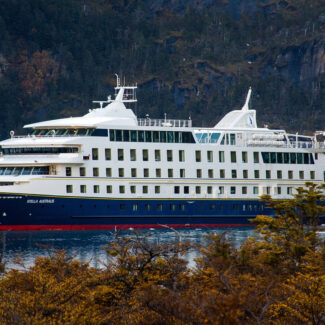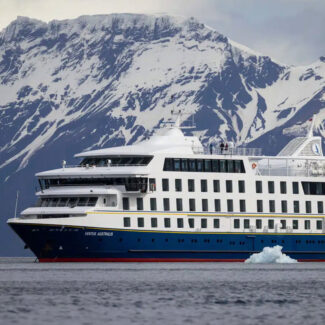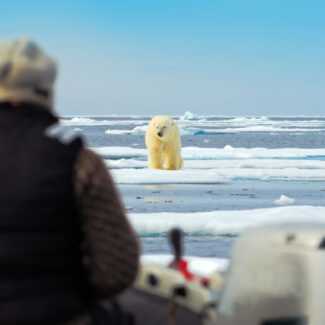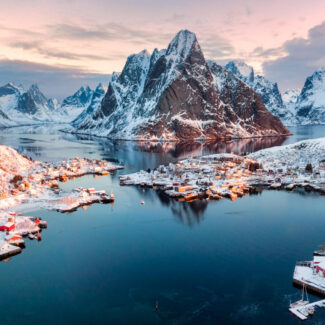Franklin's Lost Expedition & The Search For Erebus & Terror
There is arguably no better-known tragedy in the chronicles of Arctic exploration than the doomed 1845-1848 British expedition of Sir John Franklin, which set out to penetrate the Northwest Passage and ended up vanished within its only partly charted depths. Today, cruisegoers in the Passage can retrace the steps of Franklin’s lost expedition, which has haunted imaginations for more than 150 years.
Sir John Franklin
Born in 1786 in Lincolnshire, John Franklin logged quite the career ahead of his final fateful adventure. Joining the Royal Navy as a teenager, he participated in the Battle of Trafalgar (Napoleonic Wars) in 1805 and the Battle of New Orleans (War of 1812) in 1815.
As part of the 1818 Arctic expedition led by Captain David Buchan, Franklin commanded the Trent. He headed an overland expedition eastward along the Canadian coast from the Coppermine River in 1819-1822 and charted hundreds of miles of seashore west of the mouth of the Mackenzie River into present-day Alaska on an 1825-1827 journey.
Knighted two years after that expedition, Franklin governed Van Diemen’s Land—now Tasmania—from 1836 to 1843.
Although Franklin was not the first choice, Second Secretary of the Admiralty Sir John Barrow, who’d commissioned multiple voyages in quest of the Northwest Passage, ultimately selected him to lead the 1845 attempt.
Meet the man behind the ill-fated voyage! This 1845 portrait captures Sir John Franklin just before his expedition set sail – little did they know the mysteries and tragedies that awaited them in the Arctic.
Source: Maritim Greenwich Souvenir Guide, London 1993, Public domain, via Wikimedia Commons
The Lost Franklin Expedition
The voyage would proceed on two ships, the HMS Erebus—which Franklin would captain, with James Fitzjames his second-in-command—and the HMS Terror, helmed by Francis Crozier. Erebus and Terror were vessels of notable polar pedigree, having journeyed to the Antarctic on the 1841-1844 expedition of James Clark Ross, and they were specially equipped for the rigors of the high latitudes, with extra iron and wood in their bows to contend with ice and an internal steam-heating system to combat the severe cold, among other features.
The expedition embarked from Greenhithe, Kent on May 9, 1845, outfitted with livestock and poultry for initial fresh fare and some 8,000 tins of canned food prepared—though, maybe crucially, under a major time crunch—with the latest storage technology by provisioner Stephen Goldner. (A few animals not for eating were also onboard: a Newfoundland dog, a cat for keeping rats in check, even a pet monkey.)
The Erebus and Terror passed through the Orkneys, then on to Greenland, where, in Disko Bay on the western coast, final preparations for the Northwest Passage try were made and what would end up being the last letters home sent.
In late July of 1845, two whaleships—the Prince of Wales and Enterprise—logged the final firmly documented sighting of the Franklin Expedition in Baffin Bay, ahead of its entry into Lancaster Sound.
The Erebus and Terror subsequently vanished, and clues to the expedition’s fate would be years and decades coming—with the story still unraveling today.
Charting the ghosts of the Arctic! This map illustrates the suspected paths of Franklin’s ships through the treacherous Northwest Passage – a silent testament to the enduring mystery of their disappearance.
Source: Finetooth, Kennonv, U.S. Central Intelligence Agency, Public domain, via Wikimedia Commons
Searching for the Franklin Expedition
As a few years went by with no word on or from the expedition, a concerted effort by Franklin’s wife, Lady Jane Franklin, and others prompted the British government to organize the first search party in 1848. More than 30 such expeditions would be sent by 1859: a massive effort that reflected huge concern and curiosity on the part of the English public as to the fate of this high-profile Northwest Passage voyage.
These search expeditions themselves ended up adding significant knowledge about the Canadian Arctic Archipelago at the heart of the Northwest Passage as they sought clues about Franklin and his men. Indeed, the very first transit of the Passage—a combination seafaring and overland journey that was ultimately a desperate escape from an icebound ship—was achieved in 1854 by Robert McClure’s Investigator crew, which had been sent as part of a multi-vessel undertaking seeking answers to the Franklin Expedition’s whereabouts.
Emerging Clues
In 1850, a search party discovered the first tangible clues to what happened to the Franklin Expedition: the remnants of its 1845-1846 winter encampment on Beechey Island. The camp included the graves of three expedition members: John Torrington, William Braine, and John Hartnell.
Although the British government made an official declaration of the Franklin Expedition’s crew as deceased in 1854 and aborted search efforts, Lady Jane Franklin raised private funds to send another party in 1857.
In 1859, this search outfit discovered a defining piece of evidence: a two-part message left by members of the Franklin Expedition, which came to be called the “Victory Point Note,” in a rock cairn on King William Island.
The first part of the Victory Point Note was written on May 28, 1847. It described the 1845-1856 overwintering on Beechey Island, and revealed that the Erebus and Terror had become trapped in ice in mid-September 1846 off King William Island. The message concluded with: “Sir John Franklin commanding the Expedition. All well.”
But the second part of the Victory Point Note—written April 25, 1848 and signed by Crozier and Fitzjames—delivered a darker update. It told how Franklin had perished on June 11, 1847 and that some 20 other crew members were dead as well. The message also spelled out the 105 survivors’ plan: Under the leadership of Crozier, they were abandoning the iced-in ships and heading south across King George Island in an attempt to reach Back’s Great Fish River (aka the Back River) on the far northern Canadian mainland. All of these remaining expedition members apparently died on this journey, which would have involved some 400 kilometers (248 miles) of overland and over-ice travel.
Among the evidence collected by searchers in the wake of the Franklin Expedition’s disappearance were the accounts and artifact-acquisitions of local Inuit people, which suggested a desperate survival situation had played out among a starving and malady-plagued crew. These included a First Nations report, collected by Dr. John Rae of the Hudson’s Bay Company in the mid-1850s, of about 40 white men seen heading southward along the western shore of King William Island circa-1848. Other Inuit narratives told of roughly 30 corpses discovered near the mouth of the Back River, and of a mass gravesite found in 1849 at Terror Bay but washed away by the early 1870s.
Inuit informants, including those whom Rae consulted, also spoke of signs of cannibalism among the perished white men—grisly reports initially rejected by many back home in England, but which later forensic analysis bore out.
Following the icy breadcrumbs in Franklin Strait! Modern icebreakers forge a path through the environment that held the secrets of Erebus and Terror for so long, offering new clues to this enduring Arctic mystery.
Modern Investigations & the Discovery of the Ships
The gradual accumulation of Franklin Expedition artifacts, skeletal remains (from the early-found Beechey Island graves to numerous sites on King William Island and along the coast of the Adelaide Peninsula, south of King William Island across the Simpson Strait), and Inuit reports have given researchers strong hints, if no clear-cut chronicle, as to how the tragedy might have come about.
Some of the analysis of crewmember remains has suggested the Franklin Expedition might have suffered from some degree or another of lead poisoning. The grave of Petty Officer John Tarrington, one of the three expedition members first to perish and buried on Beechey Island, was exhumed in 1984 by forensic anthropologist Owen Beattie and his team and the emaciated corpse found in a remarkable degree of preservation; an autopsy hinted Tarrington’s death may have been due to pneumonia exacerbated by lead toxicity. High lead levels were also noted in the remains of the other two men interred there, Royal Marine Private William Braine and Able Seaman John Hartnell (who appeared to have died from tuberculosis—again, perhaps brought on by lead-related weakness).
Some of the expedition’s canned rations have been found, and these relics suggest shoddy soldering may have allowed lead to leak into the food.
The bones of Franklin’s men also indicate that Vitamin C deficiency and scurvy—which expeditions of the time labored to control with citrus juice and the like—may have been an issue as well.
And certainly Inuit accounts of starving white men and corroborating forensic evidence, including of cannibalism, suggest that general lack of food surely became a profound problem for the dwindling expedition crew. In 2024, state-of-the-art DNA analysis suggested that some of the bones found on King William Island with signs of cannibalistic activity were those of none other than Captain James Fitzjames, Franklin’s second-in-command on the Erebus and later, following Franklin’s death, its captain.
The Wrecks of HMS Erebus and Terror
The mid-2010s brought massive new discoveries pertaining to the lost Franklin expedition: namely, the finding in September 2014 of the sunken wreck of the Erebus—sitting in about 36 feet of water off O’Reilly Island and the Adelaide Peninsula in the Queen Maud Gulf—and then, almost exactly two years later, the identification of the Terror, set upright on the seafloor at a greater depth in (appropriately enough) Terror Bay along the western coast of King William Island.
The wrecks were located well south of where it was long thought the ships became trapped in ice. The battened-up state of the Terror raised the possibility that the crew had taken careful preparatory steps ahead of its abandonment, possibly remaining with the Erebus longer.
Inuit insights across well more than a century helped locate the shipwrecks. Long-standing Native stories spoke of a wooden ship found right in the area where the Erebus was ultimately discovered—a place the Inuit called Ugjulik—and even of a dead man encountered inside it.
Much more recently, some six years before the Terror was located in 2016, an Inuit man named Sammy Kogvik and a hunting companion noticed what appeared to be a ship’s mast protruding from the ice of Terror Bay. Kogvik ended up as a crewmember on the Arctic Research Foundation team that found the Terror wreck, and his account helped direct the search.
Archaeological work on these wrecks—protected together as a Canadian National Historic Site—continues by Parks Canada, the Inuit Heritage Trust, and others, and has thus far yielded such finds as uniform epaulets, mustard pots, decanters, ink bottles, and boots along with the components of the ships themselves: bells, cannons, wheels, etc. As of yet, no human remains have been retrieved from the sunken vessels.
From lost to found! This map pinpoints the final resting places of HMS Erebus and Terror, discovered over 150 years after their disappearance, bringing a new chapter to the story of Franklin’s ill-fated expedition.
Source: Smurftrooper, CC BY-SA 4.0 <https://creativecommons.org/licenses/by-sa/4.0>, via Wikimedia Commons
Franklin’s Tomb?
The Erebus and Terror have been discovered; the long-rumored tomb of Sir John Francis himself has yet to be—and, indeed, may well not exist at all. The ultimate fate of Franklin’s body continues to tantalize historians and explorers alike. Some theorize—based on alleged testimonies by Pelly Bay Inuk people collected in the 1860s by Charles Francis Hall and his team—that Franklin was entombed in a special structure on the western coast of King William Island, and that this burial may even have been witnessed by the Inuit. No such gravesite has yet been found. Others have speculated that Franklin might have been given a burial-at-sea. The mystery, needless to say, lingers.
In Popular Culture
Ever since the Franklin Expedition went missing, it has captivated people around the world. The scale of its loss and the inherent mystery of how it played out helped drive public pressure on the British government to mount such a large-scale and long-running search effort. Fascination with the story has continued unabated into our times, only heightened with the astonishing discoveries (thanks to indigenous knowledge and modern technology) of the sunken Terror and Erebus.
Little surprise, then, that the Franklin Expedition has inspired droves of artistic material: from plays (e.g., the recent The Breathing Hole) and novels (such as William T. Vollman’s The Rifles, part of his highly regarded Seven Dreams cycle about indigenous North America, and Dan Simmons’ fictionalized account The Terror) to music (including songs, such as Iron Maiden’s “Stranger in a Strange Land,” inspired by photographs of John Tarrington’s exhumed corpse) and screen adaptations (among them the first season of the 2018 U.S. television series The Terror, based on the Simmons novel).
The Franklin Expedition has also been referenced in many works of art going back to the mid-19th century, perhaps most famously Edwin Landseer’s grim 1864 painting Man Proposes, God Disposes, which shows a pair of polar bears attending to the wreckage of a ship (and the bones of a dead man).
The Franklin expedition captured on canvas! This painting, “Erebus’ and the ‘Terror’ in New Zealand,” offers a glimpse of the ships before their fateful Arctic voyage, forever etching their story into both history and art.
Source: James Wilson Carmichael, Public domain, via Wikimedia Commons
Placenames
The legacy of the Franklin Expedition lives on in European placenames within the Northwest Passage, including Terror Bay itself—named in 1910 by the Geographical Names Board of Canada after the ship Crozier commanded—and Starvation Cove east of the Erebus wreck site on the Adelaide Peninsula, where Inuits found skeletal remains, perhaps of some of the final survivors, in the 1850s.
Franklin himself named a number of Arctic features on his earlier expeditions, including, in 1821, Coronation Gulf between the Nunavut coast and Victoria Island: an important waterway along the Northwest Passage.
Chasing the Ghosts of the Franklin Expedition on a Northwest Passage Cruise
Cruises to the Northwest Passage can take you along the route of the ill-fated Franklin Expedition and to such associated sites as Beechey and King William islands. It’s one thing to read about this legendary tale of polar misfortune—quite another indeed to see firsthand the Arctic land- and seascapes in which it played out.
Disclaimer
Our travel guides are for informational purposes only. While we aim to provide accurate and up-to-date information, Antarctica Cruises makes no representations as to the accuracy or completeness of any information in our guides or found by following any link on this site.
Antarctica Cruises cannot and will not accept responsibility for any omissions or inaccuracies, or for any consequences arising therefrom, including any losses, injuries, or damages resulting from the display or use of this information.








